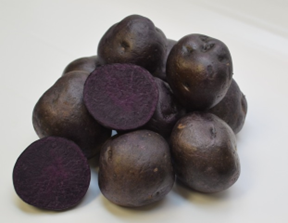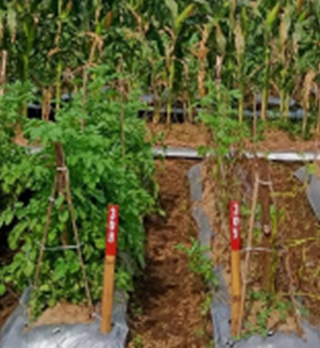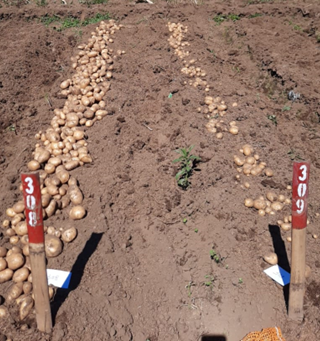Trust, Critical Thinking and Potatoes
As a scientist working in potato breeding for over 40 years, one may wonder why I am talking about trust and critical thinking.

As a scientist working in potato breeding for over 40 years, one may wonder why I am talking about trust and critical thinking. Globally, we struggle to find consensus on sustainable solutions to grand challenges, such as climate change, food security, and most recently, a pandemic. This struggle for consensus is not due to a lack of information on possible innovative solutions, but instead often rooted in our beliefs, or what we trust to be true.
Critical thinking is often derailed by misinformation and disinformation leading some to argue that these challenges are pure fiction. How can we solve these world problems if we can’t even come to consensus that they exist? The internet and social media provide the perfect cloak to those seeking to create uncertainty, doubt, and fear.
Technology has surrounded humanity with information overload. The internet and social media provide infinite access to information anytime of the day or night. But where does all this information come from and is it trustworthy and true?
Trust is anything but simple.
For a scientist this is concerning
Differing viewpoints that question the status quo are critical for a society to evolve and succeed. Science has always been the trusted mechanism to prove or disprove theories and concepts. Scientists use the scientific process by observing a problem, asking pertinent questions, testing hypotheses, and then using the data to reach an objective hypothesis that is repeatable by other researchers to reach concensus. However, many have stopped trusting in science and the scientific process and instead rely on information influencers.
In my lifetime, technological advances in agriculture have led to breakthrough and sustainable innovations with the potential to solve global problems. Yet these technologies, developed through rigorous scientific methods, are often distrusted and rejected by individuals and certain groups. This distrust of science is not isolated to a particular socioeconomic, cultural, or demographic group. Once the distrust occurs can it be regained?
Who we trust as our information influencers, along with our own personal experiences, forms our attitudes, opinions, and beliefs. The access to information, or should I say, the access to create information has never been so open and available. How do we decide which information “authors” are trustworthy and what is the truth?
Consciously or subconsciously, confirmation bias is one thing that leads us to trust information, regardless of the source. Information that matches our beliefs or values is validating. A quick internet search of any topic most likely returns information which supports our personal point of view. Fact checking the source of the information is not a high concern, because we feel an immediate connection and acceptance of the information since it agrees with and validates our beliefs.
Trust and the internet
In addition to confirmation bias, our media literacy is another factor that plays into what we deem trustworthy. Media literacy, the ability to access, analyze, evaluate, and create media in a variety of forms, is a skill that must be taught. The Center for Media Literacy expands on this general definition, including that, “media literacy builds an understanding of the role of media in society as well as essential skills of inquiry and self-expression necessary for citizens of a democracy.” Those who learn and use good media literacy skills are skeptical of all information until it can be personally vetted for accuracy and truth. If origin and data sources can’t be validated, the information is deemed not trustworthy.
Enter potatoes
For many decades, my research has focused on genetically improving potatoes. Many think of potatoes as a less than ideal nutrition choice. The potato itself is a nutritional powerhouse, but it’s how we choose to prepare and eat them that often overshadows their nutritive benefits. Nutritionally, potatoes produce a large amount of energy-rich carbohydrates and is high in vitamin C and potassium. Through cross-breeding, I have also developed a deep, purple-fleshed potato that is high in antioxidants typically found in fruits.

As the third most important human food in the world, potatoes can play a critical role in global food security. Over the last few decades world potato production growth has primarily been in developing countries. As the highest-yielding staple crop per acre, potatoes provide countless savings in land use across the globe. Despite increased potato production and high yield potential, yields in developing countries have not reached their full potential. Smallholder farmers often lack access to quality seed and knowledge of effective disease management practices.
One of the most important potato diseases due to its impact on crop yield is late blight (the disease that caused the Irish potato famine in 19th century). Late blight disease is recognized as one of the most destructive diseases of potato and is a major constraint of profitable potato production worldwide. Late blight management costs and losses from yield reductions are estimated at over $6 billion a year globally. Since the disease can occur at any point in the cropping cycle after plant emergence, growers in high disease pressure areas, like Indonesia, may apply as many as 20 or more fungicide sprays in a single growing season.
The best way to overcome the problem of late blight is to produce a potato with durable resistance to the disease. An innovative solution to the grand challenge does exist, but the solution does not enjoy a consensus of support around the globe. Late blight disease resistance can be achieved in potato through the introduction of three strong disease resistance genes from wild species of potato into varieties preferred by consumers and farmers. These resistant varieties cannot be obtained by conventional cross-breeding.
Genetically modified organisms – GMOs
The late blight resistant potato I refer to was developed using genetic engineering (GE), a scientific process that can insert and express genes (DNA) to improve an organism. This technology has been celebrated or villainized, depending on whom you trust. As a plant breeder, I believe GE expands the toolbox that a breeder can use to solve challenges, especially in vegetative crops like potato, where specific varieties are preferred in the market.
In medicine, one of the most recognizable examples of is in the production of human insulin which is manufactured using recombinant DNA technology. It has been licensed for human use since 1982 and widely prescribed to treat diabetes. GE has been widely accepted by the public in medical applications.
In agriculture, despite over 25 years of successful commercial production of many staple crops, GE crops still endure stiff criticism. The anti-GMO movement is well-funded and well-organized. Three claims of anti-GMO advocates are that GE is harmful to human and environmental health; that GMOs are unnatural; and were developed by large multi-national corporations looking to control the seed sector and farmers. These beliefs persist even after overwhelming scientific evidence continues to prove that current GMOs are safe to eat, and that disease and insect resistant GMOs can be good for the environment and health of farmers, and in many cases reduce input costs.
Risk or benefit?
A recent review offers a risk-benefit analysis of GMOs. The authors note that scientific evidence shows the technology is not only safe, but can also provide economic, environmental, and health benefits. In addition, legal frameworks that regulate GM crops exist to ensure safe products for people, animals, and the environment.
As director of the Feed the Future Global Biotech Potato Partnership supported by the U.S. Agency for International Development (USAID), I have seen first hand the benefits of the GE technology. The partnership is working to develop late blight resistant potato varieties in developing countries. Our late blight disease resistant potatoes have demonstrated complete protection against the disease. We have held field trials in Indonesia, where late blight disease is so prevalent, it can strike soon after plant emergence and destroy an entire potato field within weeks. On average, Indonesian farmers spray up to 17 times during a 90-day cropping cycle. That equates to two to three times a week where farmers are exposed to fungicides sprays, and often times they apply without proper protective clothing.
In the photos below you can see a row of the late blight disease resistant potato plants next to a row of the conventional plants taken during a recent confined field trial in Indonesia.


As for the safety of the GE technology, we circle back to where we began in this article, with trust.
Science and regulatory agencies around the globe have consistently found crops and food developed by GE to be safe. In fact, 159 Nobel Laureates to date have signed an open letter to the Leaders of Greenpeace (an outspoken opponent of the technology), the United Nations and Governments around the world in support of biotechnology, noting, “There has never been a single confirmed case of a negative health outcome for humans or animals from their consumption. Their environmental impacts have been shown repeatedly to be less damaging to the environment, and a boon to global biodiversity.” I find this as trustworthy evidence that the GE technology is indeed safe.
The opportunity of choice
Wherever you may land in the GMO trust conversation, the technology is growing and expanding. In 2019, 190.4 million hectares of biotech crops were grown in 29 countries. The U.S. leads the world with 71.5 million hectares with an average 95 percent crop adoption rate for GE soybeans, maize, and canola (ISAAA Brief 55). According to the USDA, over 90 percent of U.S. corn, upland cotton, and soybeans are GE varieties. I think it is fair to say that GE crops are here to stay.
In the U.S., which many consider a privileged society, people have many options and choices when it comes to making their food decisions. We are fortunate to have the opportunity of choice. Many developing countries struggle to achieve food security and cannot produce enough nutritious food to feed their people.
The State of Food Security and Nutrition in the World 2021 report by FAO notes that 149.2 million, or 22 percent, of children under 5 years of age were affected by stunting and 45.4 million children were affected by wasting (low weight for height). More than nine out of 10 of all children affected by stunting or wasting are in Africa and Asia. The study also reports that undernourished people in Africa (418 million) and Asia (282 million) rose by 103 million people from 2019 to 2020.
We cannot just ask farmers to grow more of what they’ve been growing to solve global food security. Farmers need to have a choice to grow more strategic crops and varieties that achieve higher and more stable yields resilient to climate shocks and threats. This choice is even more critical in developing countries like Bangladesh where we are working to bring the late blight disease resistant potato to smallholder farmers. Genetic engineering can offer disease and pest resistant and climate tolerant crop plants for the farmers. GE crops can also lead to improved and enhanced nutritional traits in food products for the consumers.
In industrialized countries such as the U.S. and Europe, agricultural productivity can be easily increased through new technologies and innovations at every point within the food value chain. We are afforded the luxury of opportunity. However, for the smallholders in a country like Bangladesh, farming can be an entirely manual process, from plowing, to planting and weeding, to harvest by hand. Technology and innovation are often out of reach for these farmers.
Many of those from the developed world can choose to select which organic, GE, or conventionally bred food products to buy at a nearby store full of options. Billions of others are not afforded this choice. However, many GMO critics are making the choice for a farmer in Africa or Asia on which crops to grow and feed their communities by fighting against their use. These opinions of distrust of the technology are often loud, misleading of the science, and influence leaders of developing countries to ban their farmers access to the technology. I believe every country and every farmer should have the right to make safe choices on their food security without the influence of disinformation and dissatisfaction of others.
We need to trust data, science, and facts to solve global grand challenges. Sharpening our media literacy and critical thinking skills will enable us to avoid disinformation, eliminate participation in misinformation sharing, and become advocates of truth.



 Print
Print Email
Email




